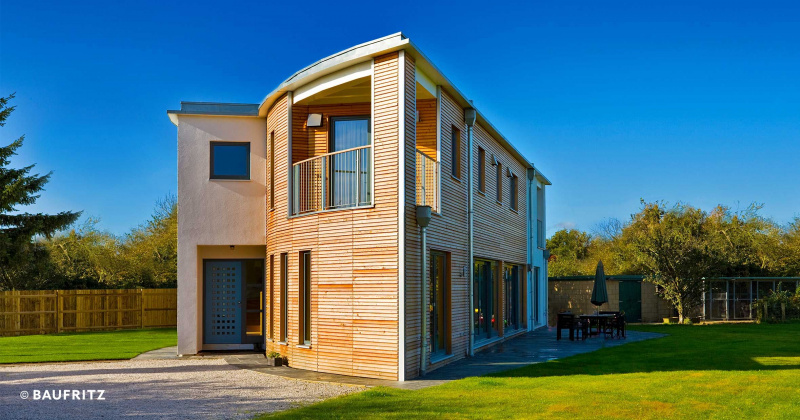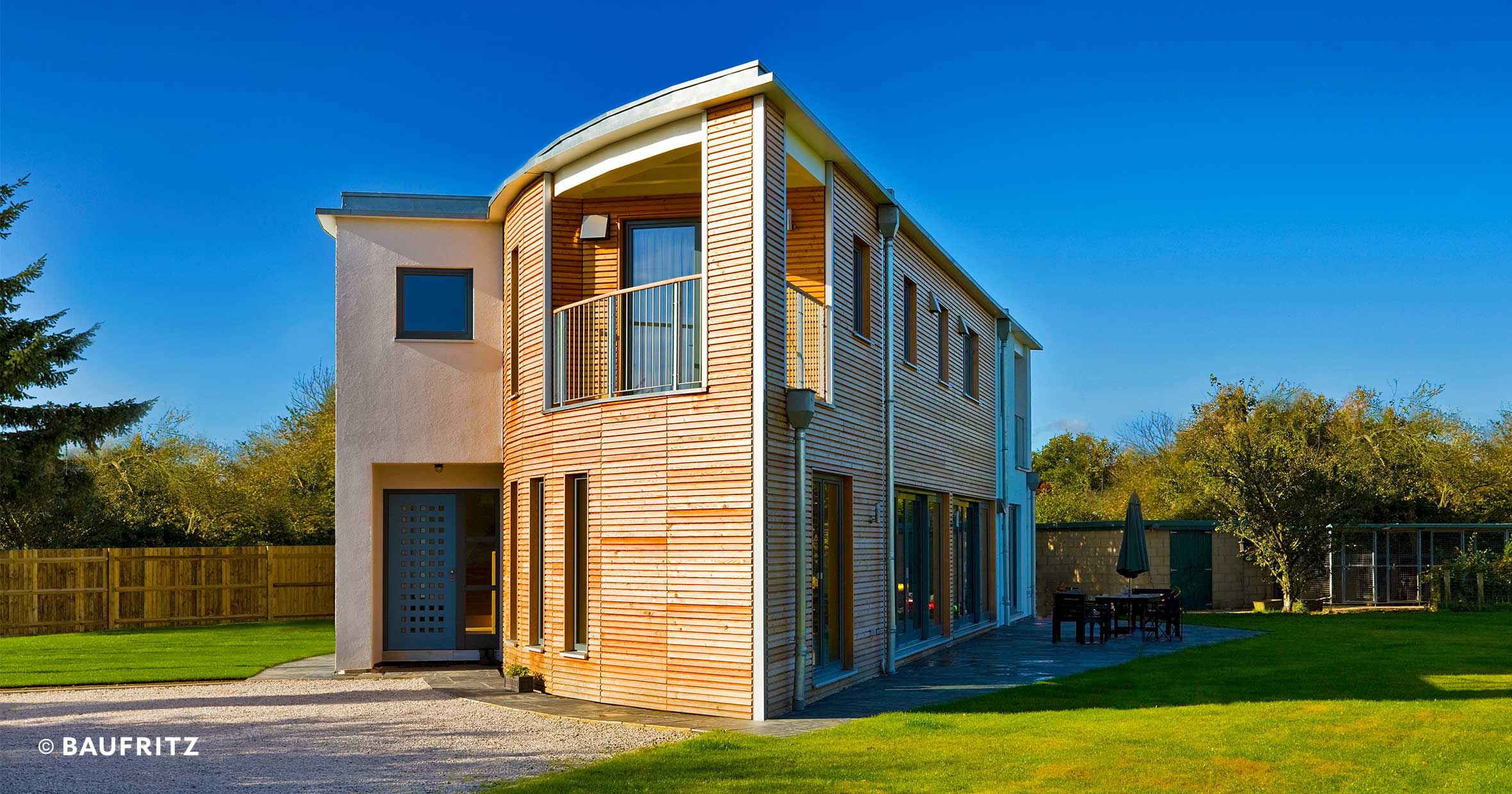File:1-exterior-view-house-ainsworth-hales.jpg
[edit] Eco houses – environmentally-friendly architecture
Sustainability, #FridaysForFuture, renewable energies, environmentally-friendly, CO2 footprint ... words we can no longer imagine daily life without. However, it is not only the vocabulary that is changing, people's awareness of, and their attitude towards, climate change is also shifting and its impacts can no longer be ignored. This is the reason why more and more people are becoming interested in living in a green and healthy house - a so-called "eco-house". These are houses that are built out of natural materials whilst at the same time successfully combining modern architecture and comfort. Biologically-constructed healthy-living homes appear to be the way forward.
The aim of this 'green architecture' is to minimise the actual resources that go into the construction and the subsequent use of the house, whilst at the same time reducing the detrimental effects that the emissions, pollution and the waste of the eco-house has on the environment.
Almost half of the respondents to a Statista survey said that they could imagine living in an eco-house. These days, eco homes can look just like a conventional house, however, some of the ecological materials used to build them may remain visible due to the fact that they provide a sense of well-being. Wood is one example of this because it creates a good living environment and a pleasant indoor climate due to its natural moisture regulation.
The materials used in the intelligent construction of eco-houses are pollutant-free, have been grown sustainably and often locally, and they also have a low impact on the environment. In most cases, a high proportion of the ecological materials used to construct eco homes can be returned to the natural cycle without leaving any trace when the house is no longer lived in.
Due to the sustainability of the natural building materials used, eco houses are very energy efficient and save resources. These properties enable the eco-house to have a positive impact on finances making them a good investment at a time when energy prices are rising.
Energy savings are one of the main advantages of eco-homes, which are a result of its intelligent construction. These can be achieved, for example, by utilising the sunlight or other renewable energies to minimise heating and electricity costs. These eco-friendly homes also are well insulated and many of them have a storage facility for self-sufficient power.
Whilst being kind to the environment, there is no need to forfeit the brilliance of architectural design, as the above house in Ainsworth Hales clearly illustrates. Individual concepts according to taste and financial means, which also include cutting-edge technology are possible.
In some eco houses, the occupants are given a great level of freedom in which they can generate the supply of energy and to store energy in modern self-powered storage systems. This enables them to be partially or completely independent of external energy suppliers.
There are many different types of an eco-house, which use a whole range of methods for generating and storing energy. Here are some examples:
Solar house: This eco house type is supplied with thermal energy which is generated using solar power. This usually entails a solar system is attached to the roof of the house. The solar heat is then stored in a stratified hot water tank. About 2/3 of the demand for hot water and about 5 % of the energy required for heating can be covered with this method.
Passive house: The walls of a passive house are insulated so well that heating costs can be kept to a minimum. As a result of the good insulation, the heat that is emitted by appliances or which comes from the sunlight is retained in this type of eco-home for a long period, which helps reduce the amount of additional heat required. The positive effect is that the eco-house is kept warm in winter and pleasantly cool in the summer.
Plus energy house: This type of eco-house is equipped intelligently with photovoltaic systems and thermal solar systems, which enables it to generate more energy than is consumed by the occupants. The plus energy house's surplus energy can be fed into the public grid, which brings in extra money for the eco-house owners.
Energy self-sufficient house: The energy self-sufficient house is also a very attractive method of house construction it allows the residents to be (almost) independent of any external energy suppliers. This type of eco-house can produce and store sufficient energy to enable the residents to become self-sufficient. The electricity that they use is generated by themselves and stored using modern storage technology.
There are also various energy concepts, which use diverse technologies to achieve the required energy savings. These include gas condensing technology, for example, in which gas is converted to heat, which together with the utilisation of the condensation heat from the developing gases, leads to a reduction in energy consumption of up to 20%. Another example of an energy concept is geothermal, whereby the surface-geothermal heat from the land is delivered via a pump into the property and is then used for heating and hot water.
Environmentally-friendly architecture and construction not only helps reduce pollution, conserve natural resources and also diminish the negative impacts in the environment. The owners of eco-houses also gain benefits of an environmental, social and economic nature. Furthermore, this kind of green building is a healthy option for the occupants, especially due to the safety of the materials used.
One other important consideration, which has a wide impact is the fact that particularly self-sufficient eco houses contribute to reducing the strain on local resources since they use modern technologies to increase both water and the energy efficiency, thereby easing the pressure on the local shared resources.
All in all, eco houses with their green construction techniques enable their owners to meet their housing needs effectively whilst at the same time preventing the environment from being endangered, as well as using energy resources both responsibly and efficiently without their health or comfort being jeopardised.
--BaufritzUK 09:22, 23 Dec 2019 (BST)
File history
Click on a date/time to view the file as it appeared at that time.
| Date/Time | Thumbnail | Dimensions | User | Comment | |
|---|---|---|---|---|---|
| current | 09:03, 23 December 2019 |  | 2,360 × 1,240 (451 KB) | BaufritzUK (Talk | contribs) | (eco-friendly Home "House Ainsworth Hales" ) |
- Edit this file using an external application (See the setup instructions for more information)
File usage
The following 2 pages link to this file:
Featured articles and news
Infrastructure that connect the physical and digital domains.
Harnessing robotics and AI in challenging environments
The key to nuclear decommissioning and fusion engineering.
BSRIA announces Lisa Ashworth as new CEO
Tasked with furthering BSRIA’s impressive growth ambitions.
Public buildings get half a million energy efficiency boost
£557 million to switch to cleaner heating and save on energy.
CIOB launches pre-election manifesto
Outlining potential future policies for the next government.
Grenfell Tower Inquiry announcement
Phase 2 hearings come to a close and the final report due in September.
Progress from Parts L, F and O: A whitepaper, one year on.
A replicated study to understand the opinion of practitioners.
ECA announces new president 2024
Electrical engineer and business leader Stuart Smith.
A distinct type of countryside that should be celebrated.
Should Part O be extended to existing buildings?
EAC brands heatwave adaptation a missed opportunity.
Definition of Statutory in workplace and facilities management
Established by IWFM, BESA, CIBSE and BSRIA.
Tackling the transition from traditional heating systems
59% lack the necessary information and confidence to switch.
The general election and the construction industry
As PM, Rishi Sunak announces July 4 date for an election.
Eco apprenticeships continue help grow green workforce
A year after being recognised at the King's coronation.
Permitted development rights for agricultural buildings
The changes coming into effect as of May 21, 2024.
























